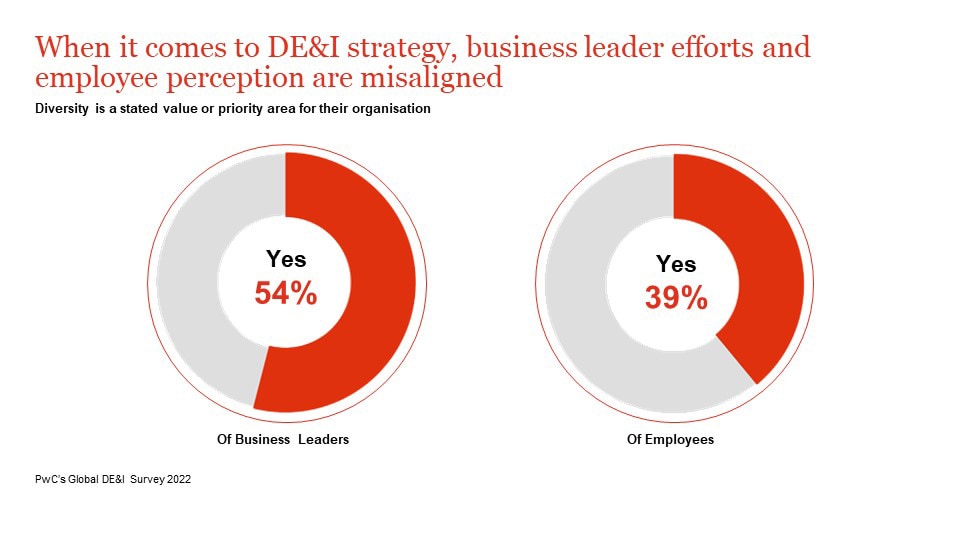

New world. New skills.
The need to upskill and reskill the workforce has never been more urgent. Everyone should be able to live, learn, work and participate in the digital world. Learn more about PwC's upskilling programme.
Company initiatives around culture, value and purpose will be critical for shaping the future of work, with almost half of business leaders saying those initiatives will differentiate them in a competitive market for talent. As employees, customers, and investors increasingly demand that the organisations they do business with model values of equity and inclusion, organisations are investing at unprecedented rates in DE&I programmes. In doing so, they hope to not only drive higher engagement with these stakeholders, but also enhance financial performance and enable innovation.
Yet, despite this heightened commitment, organisations still have progress to make in designing and executing DE&I programmes. Only 4% of organisations are succeeding in key dimensions of successful DE&I programming.
Continue reading to explore the results of the survey and the causes of this dissonance. Then, take the survey to analyse the maturity of your organisation’s DE&I programme.


In our experience, the DE&I programmes that are most effective at realising their goals are comprised of four key elements:
Initiating a continuous process for understanding the facts of what’s happening inside the organisation today. Examples include:
Below are a few examples of areas for organisations to focus on to address and improve the dissonance between business leaders and employees when it comes to DE&I strategies.
Business leaders - who may be supportive of DE&I efforts but are further removed from the day-to-day programme activity - may have misconceptions about what’s actually in place in their organisations. As organisations all have subcultures, business leaders may also not be as attuned to behaviors in the workplace that are causing employees to feel that their environment is not inclusive. On the other hand, employees may not be aware of good work that is happening (e.g. data collection across different dimensions of diversity). Both misconceptions need to be corrected to have authentic leadership support and employee engagement in DE&I.
So what can you do to make sure you’re getting the most out of your DE&I investments and effectively engaging all personas in building a more inclusive culture? Start with asking yourself some of the key questions below:
Use these questions as conversation starters; discussions about sensitive political and social issues aren’t the divisive, polarizing distraction that leaders might fear. They can lead to a better understanding of colleagues, a more open and inclusive work environment, and increased empathy. The majority of employees are now saying that transparency is extremely important around their organisation’s record on addressing diversity and inclusion in the workplace.
Read more findings about DE&I conversations here in PwC's Global Workforce Hopes and Fears Survey 2022.
Explore the data sheets below to start a conversation within your organisation.


The UK has slipped from 17th to 18th place, down from 10th in 2020 - the steepest post-pandemic decline amongst OECD countries - with Iceland, New Zealand and Luxembourg the best performing.


We asked 3,200 survey participants to reflect on their experiences in the context of the COVID-19 crisis. The results show that for some, organisational culture has been the hero of their pandemic story.


Explore key findings from PwC’s Workforce Hopes and Fears 2022 survey of 52,000+ workers across 44 countries and territories worldwide. Learn more today!